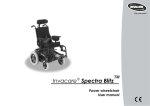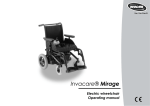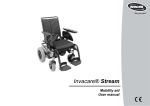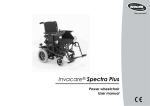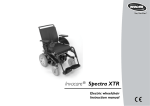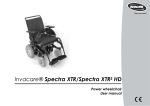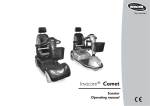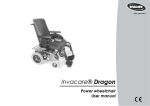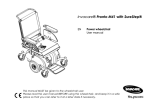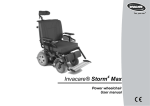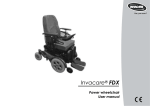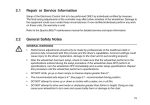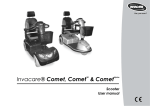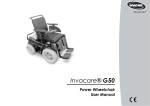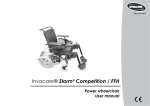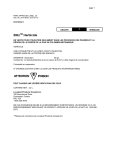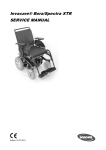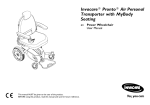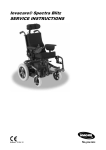Download Spectra Blitz User manual
Transcript
Yes, you can.® ® TM Invacare Spectra Blitz Power wheelchair User manual 2 How can you get in touch with Invacare®? If you have any questions or need support, please contact your authorised Invacare® Dealer, who has the necessary know-how and equipment plus the special knowledge concerning your Invacare® product, and can offer you all-round satisfactory service. Should you wish to contact Invacare® directly, you can reach us in Europe at the following addresses and phone numbers. Invacare Austria GmbH Herzog Odilostrasse 101 A-5310 Mondsee Austria : Fax: @: WWW: +43 6232 5 53 50 +43 6232 5 53 54 [email protected] www.invacare.at Invacare n.v. Autobaan 22 B-8210 Loppem (Brugge) Belgium : Fax: @: WWW: +32 (0)50 83 10 10 +32 (0)50 83 10 11 [email protected] www.invacare.be Invacare AG Benkenstraße 260 CH-4108 Witterswil Switzerland : Fax: @: WWW: +41 (0)61487 70 80 +41 (0)61487 70 81 [email protected] www.invacare.ch Invacare GmbH Alemannenstraße 10 88316 Isny Deutschland Fax @: WWW: +49 (0)7562 70 00 +49 (0)7562 7 00 66 [email protected] www.invacare.de Invacare A/S Sdr. Ringvej 37 DK-2605 Brøndby Danmark (Kundeservice): Fax (Kundeservice): @: WWW: Invacare® SA c/ Areny s/n Polígon Industrial de Celrà E-17460 Celrà (Girona) ESPAÑA : Fax: @: WWW: +45 (0)36 90 00 00 +45 (0)36 90 00 01 [email protected] www.invacare.dk +34 (0)972 49 32 00 +34 (0)972 49 32 20 [email protected] www.invacare.es 3 Invacare® Poirier SAS Route de St Roch F-37230 Fondettes France : Fax: @: WWW: Invacare® Ltd Pencoed Technology Park Pencoed Bridgend CF35 5AQ United Kingdom (Customer services): Fax (Customer services): @: WWW: Invacare Mecc San s.r.l. Via dei Pini, 62 I - 36016 Thiene (VI) ITALIA : Fax: @: WWW: +39 0445 38 00 59 +39 0445 38 00 34 [email protected] www.invacare.it Invacare Ireland Ltd. Unit 5 Seatown Business Campus Seatown Rd, Swords County Dublin Ireland : Fax: @: WWW: +353 18 10 70 84 +353 18 10 70 85 [email protected] www.invacare.ie Invacare® AS Grensesvingen 9 Postboks 6230 Etterstad N-0603 Oslo Norge (Kundeservice): Fax (Kundeservice): @: @: WWW: +47 (0)22 57 95 00 +47 (0)22 57 95 01 [email protected] [email protected] www.invacare.no Invacare® B.V. Celsiusstraat 46 NL-6716 BZ Ede Nederland : Fax: @: @: WWW: +31 (0)318 69 57 57 +31 (0)318 69 57 58 [email protected] [email protected] www.invacare.nl : : Fax: @: WWW: +351 225 10 59 46 +351 225 10 59 47 +351 225 10 57 39 [email protected] www.invacare.pt Invacare Lda Rua Estrada Velha, 949 P-4465-784 Leça do Balio Portugal 4 +33 (0)247 62 64 66 +33 (0)247 42 12 24 [email protected] www.invacare.fr +44 (0)1656 77 62 22 +44 (0)1656 77 62 20 [email protected] www.invacare.co.uk Återförsäljare: Invacare® AB Fagerstagatan 9 S-163 91 Spånga Sverige (Kundtjänst): Fax (Kundtjänst): @: @: WWW: Tillverkare: Invacare® Deutschland GmbH Kleiststraße 49 D-32457 Porta Westfalica Deutschland MÖLNDAL : Fax: @: Eastern european countries European Distributor Organisation (EDO) Kleiststraße 49 D-32457 Porta Westfalica Deutschland +46 (0)8 761 70 90 +46 (0)8 761 81 08 [email protected] [email protected] www.invacare.se +46 (0)31 86 36 00 +46 (0)31 86 36 06 [email protected] LANDSKRONA : Fax: @: +46 (0)418 2 85 40 +46 (0)418 1 80 89 [email protected] OSKARSHAMN : Fax: @: +46 (0)491 1 01 40 +46 (0)491 1 01 80 [email protected] Fax @: WWW: +49 (0)5731 75 45 40 +49 (0)5731 75 45 41 [email protected] www.invacare.de 5 Table of Contents Chapter 1 Introduction 1.1 1.2 1.3 1.4 1.5 1.6 1.7 2 6 18 General safety notes ...............................................................................................................18 Safety information with regard to care and maintenance ...................................................21 Safety information on electromagnetic interference ...........................................................22 Safety information on driving and freewheel mode.............................................................23 Safety information regarding changes and modifications to the mobility device............25 Some Useful Tips The position of the labels on the product Getting in and out of the wheelchair Driving 6.1 6.2 10 Important symbols in this manual .........................................................................................11 Important symbols found on the vehicle ..............................................................................13 Type classification and permissible use...............................................................................15 Indications................................................................................................................................16 Usability....................................................................................................................................16 Warranty ...................................................................................................................................17 Life expectancy........................................................................................................................17 Safety notes 2.1 2.2 2.3 2.4 2.5 3 4 5 6 Page 27 29 30 32 Before driving for the first time..............................................................................................32 Parking and stationary............................................................................................................33 6.2.1 Activating and deactivating the manual wheel lock ......................................................33 6.3 6.4 6.5 7 Pushing the mobility device in freewheel mode 7.1 8 9.4 9.5 9.6 9.7 39 Remote mounting hardware ...................................................................................................40 Adjusting the wheelchair to the user's seating posture 9.1 9.2 9.3 37 Disengaging motors................................................................................................................37 Remotes 8.1 9 Taking Obstacles.....................................................................................................................34 6.3.1 Maximum obstacle height .............................................................................................34 6.3.2 Safety information when ascending obstacles .............................................................34 6.3.3 The correct way to overcome obstacles .......................................................................35 Driving up and down gradients..............................................................................................36 Use on public roads ................................................................................................................37 41 Installing/Removing Armrests................................................................................................42 Armrest Adjustment ................................................................................................................44 Adjusting the backrest............................................................................................................46 9.3.1 Adjusting the backrest angle ........................................................................................46 9.3.2 Adjusting the backboard position..................................................................................47 9.3.3 Adjusting Backpost Support Bracket ............................................................................48 9.3.4 Adjusting the tension adjustable backrest upholstery ..................................................49 9.3.5 Installing / Removing Back Cushion .............................................................................50 Seating......................................................................................................................................51 9.4.1 Installing / Removing Seat Cushion..............................................................................51 9.4.2 Adjusting the seat width................................................................................................52 9.4.3 Adjusting the seat depth ...............................................................................................53 9.4.4 Installing / Removing Seat Board .................................................................................54 9.4.5 Adjusting the seat angle ...............................................................................................54 Adjusting the headrest............................................................................................................56 Adjusting the trunk supports .................................................................................................57 Adjusting Push Handles .........................................................................................................59 7 9.8 Postural belts ...........................................................................................................................59 9.8.1 Types of postural belts..................................................................................................60 9.8.2 Adjusting the postural belt correctly..............................................................................61 10 Adjusting footrests and legrests 10.1 10.2 10.3 10.4 Installing / Removing legrests................................................................................................62 Legrest height adjustment......................................................................................................63 Adjusting the angle and depth adjustable foot plate...........................................................64 Adjusting / Replacing Foot Plate Heel Strap (if fitted).........................................................65 11 Electrical system 11.1 11.2 8 66 Electronics protection system ...............................................................................................66 Batteries ...................................................................................................................................67 11.2.1 Charging the batteries ..................................................................................................67 11.2.1.1 General information on charging .............................................................................67 11.2.1.2 General instructions on charging.............................................................................67 11.2.1.3 How to charge the batteries.....................................................................................68 11.2.1.4 How to disconnect the batteries after charging .......................................................69 11.2.2 Storage and Maintenance.............................................................................................70 11.2.3 Instructions on using the batteries................................................................................70 11.2.4 Transporting batteries...................................................................................................72 11.2.5 Handling batteries.........................................................................................................72 11.2.5.1 General instructions on handling the batteries ........................................................72 11.2.5.2 How to handle damaged batteries correctly ............................................................72 12 Maintenance 12.1 12.2 62 74 Cleaning the mobility device ..................................................................................................74 Repair Instructions..................................................................................................................75 12.2.1 Adjusting Front Castors ................................................................................................76 12.2.2 Drive Wheels ................................................................................................................77 12.2.2.1 Repairing a flat tyre at the rear (wheel rim type 3.00-8").........................................77 13 Transport 13.1 13.2 Transferring the wheelchair to a vehicle...............................................................................82 Use of the wheelchair as a seat in a vehicle.........................................................................83 13.2.1 How the wheelchair is anchored in a vehicle for use as a vehicle seat .......................85 13.2.2 How the user is secured within the wheelchair.............................................................86 14 Refurbishment 15 Disposal 16 Safety Inspection Checklist 16.1 16.2 16.3 81 90 91 92 Troubleshooting - Mechanical................................................................................................94 Troubleshooting - Electrical ...................................................................................................95 Checking battery charge level................................................................................................97 17 Technical specifications 18 Inspections Performed 98 101 9 1 Introduction Dear user, First we would like to thank you for purchasing our product! We hope that you will have a great deal of pleasure with your new power wheelchair. This operating manual contains important information and notes about: • Safety • Operation • Care and maintenance Please take care to read the operating manual thoroughly before starting out on your first journey. This wheelchair has been constructed for a large circle of users with different requirements. The decision whether the model is suitable for the user may only be taken by medical specialists with appropriate expertise. Invacare® or their statutory representatives can accept no liability in cases in which the wheelchair has not been adapted to suit the users’ handicaps. Some maintenance and settings can be performed by the user or his/hers attendants. Certain adjustments do however require technical training and may only be carried out by your Invacare® specialist dealer. Damages and errors caused by nonobservance of the user manual or as a result of incorrect maintenance are excluded from all guarantees. 10 This manual contains copyrighted information. This manual may not be reproduced or reprinted either partly or completely without previous written consent from Invacare® or its statutory representatives. We reserve the right to make any necessary alterations on the grounds of technical improvements. 1.1 Important symbols in this manual General risks This symbol warns you of general hazards! • Always follow the instructions to avoid injury to the user or damage to the product. EXPLOSION HAZARD! This symbol warns you of an explosion hazard, which can be caused by excessive tyre pressure in a pneumatic tyre. • Always follow the instructions to avoid injury to the user or damage to the product. BURN HAZARD! This symbol warns you of the danger of chemical burns, for example due to the discharge of battery acids! • Always follow the instructions to avoid injury to the user or damage to the product. BURN Risk! This symbol warns of the risk of burns, for example, as a result of hot motor surfaces. • Follow the instructions in order to avoid injury or damage to the product. 11 RISK OF CRUSHING! This symbol warns of a risk of crushing caused by being careless with heavy components. • Always follow the instructions to avoid injury to the user or damage to the product. Wear eye protection This symbol refers to the requirement for wearing eye protection, for example when working with batteries. • You must wear safety goggles when this symbol is displayed. Wear protective gloves This symbol indicates the requirement to wear protective gloves, for example when working with batteries. You must wear protective gloves when this symbol is displayed. NOTE: This symbol identifies general information which is intended to simplify working with your product and which refers to special functions. Requirements: • This symbol identifies a list of various tools, components and items which you will need in order to carry out certain work. Please do not attempt to carry out the work if you do not have the listed tools available. READ WELL BEFORE OPERATION! This symbol advises you to read information carefully. 12 1.2 Important symbols found on the vehicle This product has been supplied from an environmentally aware manufacturer. This product may contain substances that could be harmful to the environment if disposed of in places (landfills) that are not appropriate according to legislation. • The 'crossed out wheelie bin' symbol is placed on this product to encourage you to recycle wherever possible. • Please be environmentally responsible and recycle this product through your recycling facility at its end of life. This symbol indicates the “Drive” position of the coupling lever. In this position the motor is engaged and the motor brakes are operational. You can drive the wheelchair. • Please note that for driving purposes both motors must always be engaged. This symbol indicates the “Push” position of the coupling lever. In this position the motor is disengaged and the motor brakes are not operational. The wheelchair can be pushed by an attendant and the wheels turn freely. • Please note that the control panel must be switched off. • Please also note the information provided in section "Pushing the mobility device in freewheel mode" on page 37. 13 This symbol indicates the position of an anchor point when using a lashing system during transport. If the symbol appears on a bright yellow sticker, the anchoring point is suitable for fixation of the wheelchair in a vehicle for use as a vehicle seat. This wheelchair may not be used as a vehicle seat! • This wheelchair does not satisfy the requirements of ISO 7176-19:2001 and may not under any circumstances be used as a vehicle seat or to transport the user in a vehicle. • Using a wheelchair that does not fulfill these criteria as a vehicle seat can lead to the most severe injuries and even death in the event of a traffic accident. This wheelchair may be used as a vehicle seat, but only if it is equipped with a headrest that has been approved by Invacare for this purpose! • Please always make sure that the wheelchair is equipped with a headrest approved by Invacare before using it as a vehicle seat! 14 If the power wheelchair is fitted with a table, it is imperative that it is removed and safely stowed when transporting the wheelchair in a vehicle! 1.3 Type classification and permissible use This vehicle was designed for persons whose ability to walk is impaired, but who are still in terms of their eyesight and physically and mentally able to operate an electric vehicle. It has been classified according to EN 12184 as a class B mobility product (for indoor and outdoor areas). It is therefore compact and agile enough for indoor areas, but also able to overcome many obstacles in outdoor areas. You can find precise information about speed, turning radius, driving range, maximum safe slope, maximum obstacle height and permissible operating conditions in chapter "Technical specifications" starting from page 98. Please also pay attention to all safety information in chapter "Safety notes" starting from page 18. The vehicle was successfully tested according to German and international standards as to its safety. It satisfies the requirements according to DIN EN 12184 including EN 1021-1/-2. It was also tested successfully according to EN60529 IPX4 as to its resistance to spray water, and is therefore well suited for typical middle European weather conditions. When equipped with an appropriate lighting system, the vehicle is suitable for use on public roads. 15 1.4 Indications The use of this mobility product is recommended for the following indications: The inability or a greatly restricted ability to walk within the scope of the basic requirement to be able to move within one’s own four walls. The need to leave the dwelling place in order to get some fresh air during a short walk or to reach those places generally to be found at close distance to the dwelling and where everyday business is carried out. Provision of power wheelchairs for interior and exterior areas is advisable if the use of handoperated wheelchairs is no longer possible on account of the disability, yet proper operation of an electromotive drive unit is still practicable. 1.5 Usability Only use a power wheelchair when it is in perfect working order. Otherwise, you might put yourself and others at risk. The following list does not claim to be exhaustive. It is only intended to show some of the situations that could affect the usability of your power wheelchair. In certain situations, you should immediately stop using your wheelchair. Other situations allow you to use the wheelchair to get to your dealer. • You should immediately stop using your power wheelchair if its usability is restricted due to: - brake failure • You should immediately contact an authorised Invacare® dealer if the usability of your power wheelchair is restricted due to: - the lighting system failing or being defective - reflectors falling off 16 - worn thread or insufficient tyre pressure - damage to the armrests (e.g. torn armrest padding) - damage to the legrest hangers (e.g. missing or torn heel loops) - damage to the postural belt - damage to the joystick (joystick cannot be moved into the neutral position) - cables that are damaged, kinked, pinched or have come loose from the holder - the wheelchair drifting when braking - the wheelchair pulling to one side when moving - unusual sounds developing or occurring Or if you have the feeling that something is wrong with your wheelchair. 1.6 Warranty The terms and conditions of the warranty are part of the general terms and conditions particular to the individual countries in which this product is sold. 1.7 Life expectancy We estimate a life expectancy of five years for this product, provided it is used in strict accordance with the intended use as set out in this document and all maintenance and service requirements are met. The estimated life expectancy can be exceeded if the product is carefully used and properly maintained, and provided technical and scientific advances do not result in technical limitations. The life expectancy can also be considerably reduced by extreme or incorrect usage. The fact that we estimate a life expectancy for this product does not constitute an additional warranty. 17 2 Safety notes READ WELL BEFORE OPERATION! 2.1 General safety notes Danger of injury if mobility device is used in any other way than the purpose described in this manual! • Only ever use the mobility device in accordance with the instructions in this User's Manual (see chapter "Type classification and permissible use" on page 15). • Pay strict attention to the safety information. Danger of injury if the mobility device is driven when ability to operate a vehicle is impaired by medication or alcohol! • Never drive the mobility device under the influence of medication or alcohol. If necessary, the mobility device must be operated by an attendant who is physically and mentally able. Danger of damage or injury if mobility device is accidentally set into motion! • Switch the mobility device off before you get in, get out or handle unwieldy objects. • When the drive is disengaged, the brake inside the drive is deactivated. For this reason, pushing the mobility device by an attendant is only recommended on flat surfaces, never on gradients. Never leave your mobility device on a gradient with its motors disengaged. Always re-engage the motors immediately after pushing the mobility device (see chapter "Pushing the mobility device in freewheel mode" on page 37). 18 Danger of injury if the mobility device is switched off while driving, for example by pressing the On/Off Button or disconnecting a cable, due to it coming to an abrupt, sharp stop! • If you have to brake in an emergency, simply release the joystick which will bring you to a halt. (refer to the joystick operating manual for more information). Danger of injury when transferring mobility device to a vehicle for transport with the occupant seated in it! • It is always better to transfer the mobility device to a vehicle without the occupant seated in it. • If the mobility device needs to be loaded up a ramp together with its driver, ensure that the ramp does not exceed the maximum safe slope (see chapter "Technical specifications" from page 98). • If the mobility device does need to be loaded using a ramp which exceeds the maximum safe slope (see chapter "Technical specifications" from page 98), then you must use a winch. An attendant can safely monitor and assist the loading process. • As an alternative you can use a platform lift. Ensure that the total weight of the mobility device including the user does not exceed the maximum permissible weight for the platform lift or winch if you are using. Danger of injury if maximum permissible load is exceeded! • Do not exceed the maximum permissible load (see chapter "Technical specifications" from page 98). • The mobility device is only designed for use by a single occupant whose maximum weight does not exceed the maximum permissible load of the device. Never use the mobility device to transport more than one person. 19 Danger of injury due to wrong lifting or dropping of heavy components! • When maintaining, servicing or lifting any part of your mobility device, take into account the weight of the individual components especially the batteries. Be sure at all times to adopt the correct lifting posture and ask for assistance if necessary. Danger of falling out of the mobility device. • Do not slide forward on the seat, do not lean forward between your knees, do not lean backwards out over the top of the backrest, for example to reach an object. • If a posture belt is installed, it should be correctly adjusted and used each time you use the mobility device. • When transferring to a different seat, position the mobility device as close as possible to the new seat. Danger of injury by moving parts! • Make sure that no injury is incurred by moving parts of the mobility device, like wheels or one of the Lifter Modules (if fitted), especially when children are around. Risk of injury from hot surfaces! • Do not leave the wheelchair in direct sunlight for prolonged periods. Metal parts and surfaces such as the seat and armrests can become very hot. Danger of fire or breaking down due to electric devices being connected! • Do not connect any electric devices to your mobility device that are not expressly certified by Invacare® for this purpose. Have all electrical installations done by your authorised Invacare® Dealer. 20 2.2 Safety information with regard to care and maintenance Danger of accident and loss of guarantee if maintenance is insufficient! • For reasons of safety and in order to avoid accidents which result from unnoticed wear, it is important that this electric mobility product undergoes an inspection once every year under normal operating conditions (see inspection plan contained in service instructions). • Under difficult operating conditions such as daily travel on steep slopes, or in the case of use in medical care cases with frequently changing wheelchair users, it would be expedient to carry out intermediate checks on the brakes, accessories and running gear. • If the mobility product is to be operated on public roads, the vehicle driver is responsible for ensuring that it is in an operationally reliable condition. Inadequate or neglected care and maintenance of the mobility product will result in a limitation of the manufacturer's liability. 21 2.3 Safety information on electromagnetic interference This electric vehicle was successfully tested in accordance with International standards as to its compliance with Electromagnetic Interference (EMI) regulations. However, electromagnetic fields, such as those generated by radio and television transmitters, and cellular phones can influence the functions of electric vehicles. Also, the electronics used in our vehicles can generate a low level of electromagnetic interference, which however will remain within the tolerance permitted by law. For these reasons we ask you to please observe the following precautions: WARNING: Danger of malfunction due to electromagnetic interference! • Do not switch on or operate portable transceivers or communication devices (such as radio transceivers or cellular phones) when the vehicle is switched on. • Avoid getting near strong radio and television transmitters. • In case the vehicle should be set in motion unintentionally or the brakes are released, switch it off immediately. • Adding electrical accessories and other components or modifying the vehicle in any way can make it susceptible to electromagnetic interference. Keep in mind that there is no sure way to determine the effect such modifications will have on the overall immunity of the electronic system. • Report all occurrences of unintentional movement of the vehicle, or release of the electric brakes to the manufacturer. 22 2.4 Safety information on driving and freewheel mode Danger of injury if the wheelchair tips over! • Inclines and declines can only be travelled up to the maximum safe slope (see chapter "Technical specifications" from page 98). • Always return the backrest of your seat or the seat tilt to an upright position before ascending slopes. We recommend that you position the seat backrest and the seat tilt (if fitted) slightly to the rear before descending slopes. • Only ever drive downhill at a maximum of 2/3 of the top speed. Avoid abrupt braking or accelerating on gradients. • If at all possible, avoid driving on slippery surfaces (such as snow, gravel, ice etc.) where there is a danger of you losing control over the vehicle, especially on a gradient. If driving on such a surface is inevitable, then always drive slowly and with the utmost caution. • Never attempt to overcome an obstacle when on an uphill or downhill gradient. • Never attempt to drive up or down a flight of steps with your wheelchair. • When overcoming obstacles, always observe the maximum obstacle height (see chapter "Technical specifications" from page 98 and information about overcoming obstacles in chapter "Taking Obstacles" from page 34). • Avoid shifting your centre of gravity as well as abrupt joystick movements and changes of direction when the wheelchair is in motion. • Never use the wheelchair to transport more than one person. • Do not exceed the overall maximum permissible load or the maximum load per axle (see chapter "Technical specifications" on page 98). • Note that the wheelchair will brake or accelerate if you change the Driving Mode whilst the wheelchair is in motion. 23 Danger of breaking down in adverse weather conditions, i.e. extreme cold, in an isolated area! • If you are a user with severely limited mobility, we advise that in the case of adverse weather conditions DO NOT attempt a journey without an accompanying attendant! Danger of injury if your foot slides off the footrest and gets caught underneath the wheelchair when it is in motion! • Make sure each time before you drive the wheelchair that your feet are squarely and securely in place on the footplates, and that both legrests are properly locked into place. Danger of injury if you collide with an obstacle when driving through narrow passages such as doorways and entrances! • Drive through narrow passages in the lowest driving mode and with due caution. If your power wheelchair has been fitted with angle-adjustable legrests, there is a danger of personal injury and damage to the wheelchair if you drive the wheelchair with the legrests raised! • To avoid unwanted displacement of the wheelchair centre of gravity to the front (especially when travelling downhill) and in order to avoid damage to the wheelchair, angle-adjustable legrests must always be lowered during normal travelling. CAUTION: Danger of tipping! Anti tip wheels (stabilisers) are only effective on firm ground! They sink in on soft ground such as grass, snow or mud if the mobility device rests itself on them. They lose their effect and the mobility device can tip over. • Only drive with extreme care on soft ground, especially during uphill and downhill journeys. In the process pay increased attention to the tip stability of the mobility device. 24 CAUTION: Tipping hazard if anti-tip wheels (1) are removed, damaged or changed to a position different to the factory settings! • Anti-tip wheels should only ever be removed for dismantling the wheelchair for transport in a vehicle or for storage. • The anti-tip wheels must always be fitted if the wheelchair is being used. 2.5 Safety information regarding changes and modifications to the mobility device CE marking of the wheelchair The conformity assessment/ CE marking was carried out in accordance with Directive 93/42 EEC / MPG (Medical Devices Act) and only applies to the complete product. The CE marking is invalidated if components or accessories are replaced or added that have not been approved for this product by Invacare. In this case, the company that adds or replaces the components or accessories is responsible for the conformity assessment/ CE marking or for registering the wheelchair as a special design and for the relevant documentation. 25 CAUTION: Danger of injuries and damage to mobility aid due to unapproved components and accessory parts! Seating systems, additions and accessory parts which have not been approved by Invacare® for use with this mobility aid can affect the tipping stability and increase tipping hazards! • Only ever use seating systems, additions and accessory parts which have been approved by Invacare® for this mobility aid! Seating systems which are not approved by Invacare® for use with this power wheelchair do not, under certain circumstances, comply with the valid standards and could increase the flammability and the risk of skin irritation. • Only use seating systems that have been approved by Invacare® for this power wheelchair. Electrical and electronic components which have not been approved by Invacare® for use with this mobility aid can cause fire hazards and lead to electromagnetic damage! • Only ever use electrical and electronic components which have been approved by Invacare® for this mobility aid! Batteries which have not been approved by Invacare® for use with this mobility aid can cause chemical burns! • Only ever use batteries which have been approved by Invacare® for this mobility aid! CAUTION: Risk of injuries, and damage to the wheelchair, if unapproved backrests are used! A retrofitted backrest which is not approved by Invacare® for use with this power wheelchair may overload the backrest tube and thus increase the risk of injuries and of damage to the wheelchair. • Please contact your Invacare® specialist dealer who will perform risk analyses, calculations, stability checks etc. to ensure that the backrest can be used safely. 26 3 Some Useful Tips Before you venture off on your first journey, ensure that everything is adjusted to your specific needs, read this manual to familiarise yourself with the product and its functions. DO NOT attempt to drive without an attendant on hand until you are fully proficient in using and manoeuvring your power wheelchair. Ensure power is switched off before entering or leaving your power wheelchair. Before switching on, check that both motors are engaged, tyres are inflated to the correct pressure and are in good condition. When on the move DO NOT attempt turns at full speed, especially while travelling downhill. Before changing from forward to reverse, and vice versa, you must stop, failure to do so will cause severe damage to the electronics. DO NOT use your power wheelchair beyond it’s limitations. Due to both the weight of a powered wheelchair and it’s occupant it is not advisable to attempt to be assisted up and down stairs whilst seated. When entering or leaving your power wheelchair, DO NOT stand on the footplates. If you have to brake in an emergency, release the joystick. DO NOT switch off power while the power wheelchair is moving, it would cause an abrupt, sharp stop. DO NOT use your power wheelchair beyond the limitations set out in this manual concerning kerb height, gradients, etc. Stability and Balance • To ensure stability and safe control of your power wheelchair you must at all times maintain proper balance. The power wheelchair is designed to remain stable and upright during normal use, so long as you do not move your centre of gravity outside the normal seating position. 27 REACHING - BENDING FORWARD • Ensure power is OFF. DO NOT lean your body forward out of the power wheelchair further than the length of the armrests. • DO NOT attempt to pick up objects from the floor by bending forward and reaching between your knees. • DO NOT attempt to reach objects by sliding forward to the edge of the power wheelchair seat. REACHING - BENDING BACKWARDS • Again ensure power is switched OFF. • DO NOT reach back any further than your arm will extend without changing your sitting position. • DO NOT lean over the top of the backrest as it will shift the centre of gravity, risking tipping over. • DO NOT hang heavy loads or objects on the backrest. They may make the power wheelchair unstable, especially on an incline. 28 4 The position of the labels on the product 1) Flammability label (upholstery) 2) Note: Remove the table before transporting 3) Identification label sticker on the chassis at the front left (also included in the pass card) 4) Identification of the lashing eyes at the front and back Warning that the wheelchair may not be used as a vehicle seat Note on required head support if the wheelchair may be used as a vehicle seat 5) Identification of the position of the engaging lever for driving and push operation (only the right side is visible in the picture) 6) Battery wiring label (inside battery boxes) The symbols on the labels are explained in section "Important symbols found on the vehicle" on page 13. 29 5 Getting in and out of the wheelchair Learning how to get in and out of a wheelchair safely and without injury is most important. Transferring to and from your powerchair may require practice and a good sense of balance. It is recommended that whenever possible you have assistance when transferring to and from your powerchair. It is recognised, however, that situations may occur when assistance is not available. It is desirable to learn and practice different techniques to accomplish a safe transfer. Many experienced wheelchair users have developed and mastered their own method of transferring to and from the chair, resulting in great independence and self-care. Such ability depends largely on the strength of the individual, their capabilities and the type of chair. No single technique would be practical, or possible, for all wheelchair users. Safety is the primary consideration in all techniques. To carry out the transfer confidently and to eliminate the possibility of personal injury, check the following: Getting into the wheelchair: • Position your wheelchair as close as possible to your seat. This might have to be done by an attendant. • Switch your wheelchair off. • Apply the manual wheel lock of your wheelchair (if existing). • Detach the skirt guard of your wheelchair or swivel it up. • Now slide into the wheelchair. 30 Getting out of the wheelchair: • Drive your wheelchair as close as possible to your seat. • Switch your wheelchair off. • Apply the manual wheel lock of your wheelchair (if existing). • Detach the skirt guard of your wheelchair or swivel it up. • Now slide onto your new seat. NOTE: If you do not have sufficient muscle strength, you should ask other persons for help. Use a sliding board, if possible. 31 6 Driving NOTE The maximum load capacity that is stated in the technical data only states that the system is designed for this mass in total. However, this does not mean that one can sit a person with this body weight in the wheelchair without restrictions. Attention must be paid to the body proportions, such as height, weight distribution, abdominal girth, leg and calf girth and seat depth. These factors have a strong influence on driving features such as tilt stability and traction. The permissible axle loads in particular must be adhered to (see chapter "Technical specifications" as from page 98)! It may possibly be necessary to carry out adaptations to the seat system. 6.1 Before driving for the first time... Before you take your first trip, you should familiarise yourself well with the operation of the vehicle and with all operating elements. Take your time to test all functions and driving modes. NOTE: If installed, make sure to properly adjust and use the postural belt each time you use the wheelchair. Sitting Comfortably = Driving Safely Before each trip, make sure that: 32 • You are within easy reach of all operating controls. • The battery charge is sufficient for the distance intended to be covered. • The postural belt (if installed) is in perfect order. • 6.2 The rear mirror (if installed) is adjusted so you can look behind at all times without having to bend forward or shift your seating position. Parking and stationary When parking your vehicle or if your vehicle is stationary for a prolonged period: • Switch the vehicle's power system off (ON-/OFF key). • Activate your anti-theft lock, if existing. 6.2.1 Activating and deactivating the manual wheel lock The manual wheel locks are located on the left and right sides above the wheels. • Pull the lever (1) upwards and backwards till it audibly locks in place. The manual wheel lock is activated. • To release the wheel lock, push the lever (1) completely forward and downward again. 33 6.3 Taking Obstacles 6.3.1 Maximum obstacle height You can find information about maximum obstacle heights in the chapter entitled "Technical specifications" from page 98. 6.3.2 Safety information when ascending obstacles CAUTION: Danger of Tipping Over! • Never approach obstacles at an angle but at 90 degrees as shown below. • Put your backrest into an upright position before climbing an obstacle. NOTE: Take care when mounting or dis-mounting a kerb. It may be possible to loose drive if the antitipping castors contact the ground. ATTENTION: Risk of falling out of the chair and damage to the power wheelchair such as broken castors! • Never approach obstacles that are higher than the maximum climbable obstacle height. For the maximum climbable obstacle height, see "Technical specifications" on page 98. • If unsure whether the kerb climb is possible or not, move away from the obstacle and if possible find another location. 34 6.3.3 The correct way to overcome obstacles Ascending Right • Approach the obstacle or the kerb slowly, head-on and at a right angle. • Depending on the wheel drive type, stop in one of the following positions: - In the case of centrally driven wheelchairs: 5 - 10 cm before the obstacle. - For all other drives: approx. 30 - 50 cm in front of the obstacle. Wrong • Check the position of the front wheels. They must be in driving direction and at right angles to the obstacle. • Approach slowly and keep at a consistent speed until the rear wheels have also passed over the obstacle. Descending The approach to descend an obstacle is the same as to ascend it with the difference that you need not stop before descending. • Descend the obstacle very slowly. 35 6.4 Driving up and down gradients For information concerning the maximum safe slope, please see chapter "Technical specifications" starting on page 98. WARNING: Danger of tipping over! • Only ever drive downhill at a maximum of 2/3 of the top speed. Avoid sudden changes of direction or abrupt braking when driving on slopes. • Always return the backrest of your seat or the seat tilt (if adjustable seat tilt is available) to an upright position before ascending slopes. We recommend that you position the seat backrest or the seat tilt slightly to the rear before descending slopes. • Always lower the lifter (if fitted) to its lowest position before ascending or descending a slope. • Never attempt to ascend or descend a slope on slippery surfaces or where there is a danger of skidding (such as wet pavement, ice etc). • Avoid trying to get out of the vehicle on an incline or a gradient. • Always drive straight in the direction the road or path you are on goes, rather than attempting to zigzag. • Never attempt to turn around on an incline or a slope. Braking distance is much longer on a downhill slope than on even terrain! • Never drive down a slope that exceeds the maximum safe slope (see chapter "Technical specifications" on page 98). 36 6.5 Use on public roads If you wish to use your wheelchair on public roads and lighting is required by national legislation, then your wheelchair needs to be equipped with an appropriate lighting system. Please contact your Invacare ® dealer if you have any questions. 7 Pushing the mobility device in freewheel mode The motors of the wheelchair are equipped with automatic brakes, preventing that the wheelchair starts rolling out of control when the joystick box is switched off. When pushing the wheelchair manually whilst freewheeling, the magnetic brakes must be disengaged. NOTE: Pushing the wheelchair by hand may require more physical force than expected (more than 100 N). The necessary force nevertheless complies with the requirements of ISO 7176-14:2008. 7.1 Disengaging motors Warning: • DO NOT engage or disengage motor locks until the power switch is in the OFF position. 37 To engage (PUSH): • Turn motor lock levers towards the rear wheels. To disengage (DRIVE): • Turn motor lock levers so they are in line with wheelchair frame. NOTE: Motor lock disengagement/engagement allows free wheeling or joystick controlled operation. Free wheeling allows an assistant to manoeuvre the wheelchair without power. NOTE: The motors may only be disengaged by an attendant, not by the user! This ensures that the motors are only disengaged if an attendant is available to secure the wheelchair and prevent unintended rolling. 38 8 Remotes Your wheelchair may be equipped with one of several different remotes. For information on the different functions and how to operate a particular remote, please see its corresponding User Manual (enclosed). 39 8.1 Remote mounting hardware Fixed joystick mounting arm This type of mounting arm can move the joystick position either away from or towards the armpad. This can be set according to comfort and arm length as follows. There is no height adjustment other than to vary the armrest height. Refer to "Armrest Adjustment" on page 44. Adjustment • Unscrew the small adjustment handwheel located on the underside of the armrest. • Slide the joystick to the desired position. Tighten the handwheel. Installing / Removal • Turn off the controller and unplug the controller communication cable (if applicable) • Unscrew the small handwheel located on the underside of the armrest. • Slide the joystick mounting arm through / into the clamping tube until it comes away / is at the desired position. • If installing re-tighten the small handwheel. 40 9 Adjusting the wheelchair to the user's seating posture CAUTION: Damage to wheelchair and accident hazard! It is possible that collisions can occur between wheelchair components due to various combinations of adjustment options and their individual settings! • The wheelchair is fitted with an individual, multiply adjustable seating system including adjustable legrests, armrests, a headrest or other options. These adjustment options are described in the following chapters. They are used to adapt the seat to the physical requirements and the condition of the user. When adapting the seating system and the seat functions to the user, ensure that no wheelchair components collide. Warning: • After ANY adjustments, repair or service and BEFORE use, make sure that all attaching hardware is tightened securely - otherwise injury or damage may result. WARNING! It should be noted that under certain conditions, and configurations of the wheelchair, ie. for users with limited / no lateral body control, and with the backrest in the reclined position, there is the potential to create a body trap between the armrest / sidepanel and the backrest. Suitable accessories are available from Invacare (lateral trunk supports) to eliminate this risk. Before sitting in the chair, make sure it is NOT switched ON. If it is ON, the battery condition indicator (10-bar display) will be illuminated. Note Initial setup should always be done by a healthcare professional. Adjustment by the user is only recommended after they have been given appropriate guidance by the healthcare professional. 41 9.1 Installing/Removing Armrests Warning: • Make sure the armrest release and height adjustment handwheels are in the locked position before using the wheelchair. NOTE: Be sure to fit the correct armrest on the corresponding side of the wheelchair. Installing • Check the armrest removal handwheel is loose and not visible inside armrest socket. • Insert bottom of armrest tube into armrest socket and gently push down. • Turn armrest removal handwheel until tight and armrest is secure. • Repeat STEPS 1-3 for the opposite side armrest. 42 Removing Warning: • Ensure the joystick unit is switched off and unplugged from the wheelchair before removing the armrest • Alternatively, remove the joystick mounting arm from the armrest following the instructions in "Remote mounting hardware" on page 40 before attempting to remove the armrest. • Turn the armrest removal handwheel (1) until loose. • Lift the armrest up and out of the armrest socket. • Repeat steps 1-2 for the opposite armrest, if necessary. 43 9.2 Armrest Adjustment Warning: • Make sure the armrest release and height adjustment handwheels are in the locked position before using the wheelchair. Height Adjustment • Loosen the armrest height adjustment handwheel (1). If the handwheel is loosened a small amount, an audible click can be heard when adjusting the armrest height. • Slowly pull up or push down on the armrest top until the desired height is achieved. • Tighten the armrest height adjustment handwheel. • Repeat STEPS 1-3 for the opposite armrest, if necessary. Armpad Adjustment • Using a cross point screwdriver, loosen the armpad fixing screws (located on the underside of the armpad). • Slide the armpad either forwards or backwards to the desired position. 44 • Tighten the armpad fixing screws. • Repeat STEPS 1-3 for the opposite armrest, if necessary. Armrest Width Adjustment Warning: • This adjustment should only be made when the wheelchair is unoccupied. • Using a hex wrench, loosen the armrest width adjustment screw (1). • Adjust the armrest position to give the desired width by gently pulling the armrest away from the seat or gently pushing the armrest towards the seat. • When adjustment is complete, tighten the armrest width adjustment screw, ensuring it is secure. • Repeat STEPS 1-3 for the opposite armrest, if necessary. 45 9.3 Adjusting the backrest CAUTION! Adjusting the seat tilt or the backrest angle changes the geometry of the mobility device and directly influences its dynamic stability! • For details regarding dynamic stability, negotiating gradients and obstacles and the correct adjustment of seat tilt or backrest angle, please see chapters "Taking Obstacles" on page 34 and "Driving up and down gradients" on page 36. 9.3.1 Adjusting the backrest angle Warning: • This adjustment should only be made when the wheelchair is unoccupied. • Take care not to damage any accessories fitted to the backrest. • Remove the safety R-clip from the end of the adjustment handwheel (1). • Unscrew handwheel from backrest. • Repeat steps 1 and 2 for opposite side. • Adjust backrest to desired angle. • Re-fit the handwheels to the available holes in the backrest. Hand tighten only. • Re-fit safety R-clip. • Repeat steps 5 and 6 for the opposite side. 46 9.3.2 Adjusting the backboard position Warning: • This adjustment should only be made when the wheelchair is unoccupied. • Take care not to damage any accessories fitted to the backrest. The backboard can be adjusted both in height and width (see "Seating" on page 51). This can be useful if another type of back cushion is to be fitted. • Remove the four fixing screws using a cross point screwdriver. • Reposition the backboard. • Replace and tighten the four fixing screws. NOTE: Ensure the backboard is firmly secured before fitting the cushion or using the wheelchair. 47 9.3.3 Adjusting Backpost Support Bracket Warning: • This adjustment should only be made when the wheelchair is unoccupied. • Take care not to damage any accessories fitted to the backrest. The backpost support bracket can be adjusted in width. This should be used when adjusting seat and backrest width (see "Seating" on page 51). • Release the set screws (1) using a hex wrench. • Slide the seating and backrest to the desired width. • Re-tighten the set screws using a hex wrench 48 9.3.4 Adjusting the tension adjustable backrest upholstery • Remove the backrest cushion (attached with Velcro strips) by pulling it up and off to access the adjustment straps. • Adjust the tension of the individual straps as desired. • Replace the backrest cushion. 49 9.3.5 Installing / Removing Back Cushion Caution: • This adjustment should only be made when the chair is unoccupied and the joystick unit switched off. Installing / Removing NOTE: The cushion inner can be removed from the fabric cover by sliding it out from the cover flap on the underside of the cushion. • Ensure the hook and loop fastener strip on the back is visible (remove covering strip if necessary, or fitted). • Position the cushion on the back with the wedge shapes at the bottom and push down to secure. • To remove, pull up on cushion to release the hook and loop fastening. Remove cushion from back. 50 9.4 Seating Caution: • These adjustments should only be made when the chair is unoccupied. • Take care not to damage any accessories fitted to the seat. 9.4.1 Installing / Removing Seat Cushion NOTE: The cushion inner can be removed from the fabric cover by sliding it out from the cover flap on the underside of the cushion. • Ensure the hook and loop fastener strip on the seat is visible (remove covering strip if necessary). • Position the cushion on the seat with the wedge shape end at the wheelchair front and push down to secure. • To remove, pull up on the cushion to release the hook and loop fastening. Remove the cushion from the seat. 51 9.4.2 Adjusting the seat width The seat can be adjusted in width. This can be useful if another type of seat cushion is to be fitted, or to better accomodate the user. Caution: • Before making the following adjustments ensure that the backpost support bracket adjustment screws are loose (see "Adjusting Backpost Support Bracket" on page 48), and the backboard is removed (see "Adjusting the backboard position" on page 47). • Failure to follow the above may result in damage to your Spectra Blitz™ seat. • Remove the seat cushion (see "Installing / Removing Seat Cushion" on page 51). • Using a hex wrench loosen the adjustment screws (1). • Gently pull/push the side of the seat, until it reaches the desired position. • Re-tighten the adjustment screws using a hex wrench. • Repeat for the opposite side of the chair. • Replace the seat cushion. NOTE: Ensure the backboard is firmly secured before fitting the cushion or using the wheelchair. 52 9.4.3 Adjusting the seat depth The seat can be adjusted in depth. This can be useful if another type of seat cushion is to be fitted, or to better accomodate the user. Seat Frame Adjustment • Remove the seat cushion (see "Installing / Removing Seat Cushion" on page 51). • Using a hex wrench loosen the adjustment screws. • Gently pull/push the side of the seat, until it reaches the desired position. • Re-tighten the adjustment screws using a hex wrench. • Repeat for opposite side of chair. Seat Board Adjustment • Remove the seat cushion (see "Installing / Removing Seat Cushion" on page 51). • Using a hex wrench loosen the adjustment screws. • Gently pull/push the side of the seat, until it reaches the desired position. • Re-tighten the adjustment screws using a hex wrench. • Repeat for the opposite side of the chair. 53 9.4.4 Installing / Removing Seat Board The seat board can be removed from the wheelchair seat frame. • Remove the seat cushion (see "Installing / Removing Seat Cushion" on page 51). • Remove the four fixing screws using a cross point screwdriver. • Install / Remove the seat board (if installing ensure that the holes on the under side of the seat board are aligned with the slots in the seat frame). • Replace and tighten the four fixing screws using a cross point screwdriver. NOTE: Ensure the backboard is firmly secured before fitting the cushion or using the wheelchair. 9.4.5 Adjusting the seat angle CAUTION! Adjusting the seat tilt or the backrest angle changes the geometry of the mobility device and directly influences its dynamic stability! • For details regarding dynamic stability, negotiating gradients and obstacles and the correct adjustment of seat tilt or backrest angle, please see chapters "Taking Obstacles" on page 34 and "Driving up and down gradients" on page 36. ATTENTION: • This adjustment should only be made when the chair is on a flat and horizontal surface. Under no circumstances should this adjustment be made while the chair is in motion, climbing obstacles or stationary on a slope. 54 Electrical adjustment of the seat angle Please consult the instruction manual for your remote for information about electric adjustment. Manual adjustment of the seat angle If your Spectra Blitz power wheelchair is fitted with a manual seat angle adjustment, refer to the following to set the required seat angle: • Remove the M 10 nut and bolt at the base of the assembly. • Rotate the female (lower) assembly clockwise to increase the seat angle or counterclockwise to decrease the seat angle. • Once the desired seat angle is achieved replace the M 10 nut and bolt and tighten the lock nut (1) against the female assembly. 55 9.5 Adjusting the headrest CAUTION: Injury hazard during use of the mobility aid as a vehicle seat if a headrest is wrongly adjusted or not installed! This can cause the neck to be hyperextended during collisions! • A headrest must be installed! The headrest optionally supplied for this mobility device by Invacare® is perfectly suitable for use during transport. • The headrest must be adjusted to the user's ear height. • Loosen the clamping lever (1, 2 or 3). • Adjust the headrest to the required position. • Retighten clamping lever. 56 9.6 Adjusting the trunk supports Installing • Ensure the trunk support fixing screws (2) are loose. • Slide the trunk support clamp (3) over the fixing tube (1) and hold at the desired position. • Tighten the trunk support fixing screws using a hex wrench. Removal • Loosen the trunk support fixing screws (2) using a hex wrench and remove the trunk support assembly. Adjusting • The trunk support height can be adjusted by loosening the fixing screws (2) and sliding the trunk support to the desired location. • To adjust the trunk support position laterally, remove the upholstered pad which is fixed using hook and eye fasteners. • Loosen the clamping screws (4) using a hex wrench. • Adjust to the desired position. • Tighten the clamping screws using a hex wrench and replace upholstered pad. 57 Swing away function The trunk supports fitted to your Spectra BlitzTM have a swing away function to enable easier access or transfer to and from the wheelchair. • Firmly grip the trunk support near the fixing tube and pull upwards to disengage the internal spring. • Swing the trunk support away from the seat. • To replace, swing the trunk support, back towards the seat and ensure it locates into position. ATTENTION: • Ensure the trunk supports are firmly locked into position before using the wheelchair. 58 9.7 Adjusting Push Handles The push handles on your Spectra BlitzTM can be adjusted to a more convenient height to allow an attendant to push or maneuver your power wheelchair if required. • Loosen the knob (1) that holds the push handle. • Raise or lower the push handle to the desired position. • Re-tighten the knob. • Repeat steps 1-3 for the other push handle. 9.8 Postural belts A postural belt is an option which can either be fixed to the wheelchair ex-works or can be retrofitted by your specialist dealer. If your wheelchair is fitted with a postural belt, your specialist dealer will have informed you about fitting and usage. The postural belt is used to help the wheelchair user keep an optimum sitting position. Correct use of the belt assists the user in sitting securely, comfortably and well-positioned in the wheelchair, especially for such users who do not have such a good sense of balance while sitting. 59 NOTE: We recommend using the postural belt whenever the wheelchair is used. The belt should be tight enough to ensure that you are sitting comfortably and that your body is in the correct sitting position. 9.8.1 Types of postural belts Your wheelchair can be fitted with the following postural belt types ex-works. If your wheelchair has been fitted with a different belt to those listed below, please ensure that you have received the manufacturer's documentation with regard to correct fitting and use. Belt with plastic buckle The belt can be adjusted on both sides. This means that the buckle can be centrally positioned. Belt with metal buckle, adjustable one side Belt can only be adjusted on one side which can result in the buckle not sitting centrally. Belt with metal buckle, adjustable both sides Belt can be adjusted on both sides. This means that the buckle can be centrally positioned. 60 9.8.2 Adjusting the postural belt correctly • Ensure that you are sitting correctly, which means that you are sitting right at the back of the seat, your pelvis is positioned erect and as symmetrically as possible, not to the front, to the side or at one edge of the seat. • Position the postural belt so that your hipbones can be easily felt above the belt. • Adjust the belt length using one of the adjustment aids described above. The belt should be adjusted so that you can fit a flat hand between the belt and your body. • The buckle should be positioned as centrally as possible. In doing so, please carry out adjustments on both sides as much as possible. • Please check your belt every week to ensure that it is still in good working condition; to ensure it has no damage or wear, and that it is fixed properly to the wheelchair. If the belt is only fastened with a bolted connection, ensure that the connection has not loosened or undone. You can find more information about maintenance work on belts in the service manual, which is available from Invacare®. 61 10 Adjusting footrests and legrests Warning: • After ANY adjustments, repair or service and BEFORE use, make sure that all attaching hardware is tightened securely - otherwise injury or damage may result. 10.1 Installing / Removing legrests • Turn the legrest to the side (the open footplate is perpendicular to the wheelchair), locate the holes on the legrest onto the pins. • Rotate the legrest towards the inside of the wheelchair until it locks into place. • Ensure the release lever is engaged. • Repeat steps 1-3 for other legrest assembly. 62 NOTE: The footplates are on the inside of the wheelchair when locked in place. Removing • Remove the legrest by pressing or pulling the lever (1). • Swing the legrest out and pull it up out of its holder (2). 10.2 Legrest height adjustment • Remove any accessory from the legrest(s). • Remove the legrest from the wheelchair. Refer to "Installing / Removing legrests" on page 62. • Lay the legrest on a flat surface to simplify the following steps. • Loosen the legrest height adjustment screws (2) using a hex-wrench. • Reposition the lower section (with the footplate) to the desired height. • Tighten the legrest height adjustment screws. Ensure the screws are secured. • Repeat steps 1-5 for the opposite side of the wheelchair legrest if necessary. • Reinstall the legrest(s) onto the wheelchair. Refer to "Installing / Removing legrests" on page 62. 63 10.3 Adjusting the angle and depth adjustable foot plate Pre-requisites: • 1x 5 mm Allen key • Use the Allen key to loosen the set screw on the foot plate (1). • Adjust the foot plate to the desired angle or depth. • Re-tighten the screw. 64 10.4 Adjusting / Replacing Foot Plate Heel Strap (if fitted) Adjusting • Undo the hook and loop fastening strap (1) and separate the two sides. • Adjust to the desired position and fasten hook and loop strips back together. • Be sure to check that your heel does not contact with the wheelchair's front castors. Replacing • Lift the heel strap (1) over the footplate pegs (2) and remove it. • Using a screw driver, remove the footplate peg fixing screws (3). • Replace them with new footplate pegs and heel straps where necessary. • Be sure to check that your heel does not contact with the wheelchair's front castors. 65 11 Electrical system 11.1 Electronics protection system The vehicle drive electronics is fitted with an overload protection. If the drive is severely overloaded over a long period (e.g. during steep climbs) and, above all, at simultaneous high external temperatures, the electronic system can overheat. In this case, the vehicle performance is gradually reduced until it comes to a standstill. The status display shows a corresponding blink code (please refer to the user manual for your remote). If you switch the drive electronics off and then on again, the error message is deleted and the electronics can be switched on again. It can however take up to five minutes until the electronics has cooled down enough for the drives to apply their full performance. If the drive is blocked due to an insurmountable obstacle, for example a kerb or similar which is too high, and the driver attempts to run the drive for more than 20 seconds against this obstacle, the electronic system switches the drives off to avoid damage. The status display shows a corresponding flash code (please refer to the user manual for your remote). If you switch the drive electronics off and then on again, the error message is deleted and the electronics can be switched on again. NOTE A defective main fuse may be replaced only after checking the entire electric system. An Invacare® specialised dealer must perform the replacement. You can find information on the fuse type in chapter "Technical specifications" starting on page 98. 66 11.2 Batteries Power is supplied by two 12 V batteries. The batteries are maintenance-free and only need regular charging. In the following, you find information on how to charge, handle, transport, store, maintain, and use batteries. 11.2.1 Charging the batteries 11.2.1.1 General information on charging New batteries should always be fully charged once before their first use. New batteries will be at their full capacity after having run through approx. 10 - 20 charging cycles (break-in period). This break-in period is necessary to fully activate the battery for maximum performance and longevity. Thus, range and running time of your mobility device could initially increase with use. Gel/AGM lead acid batteries do not have a memory effect as NiCd batteries. 11.2.1.2 General instructions on charging Follow the instructions listed below to ensure safe use and longevity of the batteries: • Charge 12 hours prior to initial usage. • We recommend charging the batteries daily after every discharge even after partly discharge, as well as each night over night. Depending on the level of discharge, it can take up to 12 hours until the batteries are fully charged again. • When the battery indicator reached the red LED range, charge the batteries for 16 hours minimum, neglecting the charge complete display! • Try to provide a 24 hour charge once a week to make sure that both batteries are fully charged. 67 • Do not cycle your batteries at a low state of charge without regularly recharging them fully. • Do not charge your batteries under extreme temperatures. High temperatures above 30 °C are not recommended for charging as well as low temperatures below 10 °C. • Use only charging devices in Class 2. This class of chargers may be left unattended during charging. All charging devices which are supplied by Invacare® comply with these requirements. • You cannot overcharge the batteries when using the charger supplied with your vehicle, or a charger that has been approved by Invacare®. • Protect your charger from sources of heat such as heaters and direct sunlight. If the battery charger overheats, charging current will be reduced and the charging process delayed. 11.2.1.3 How to charge the batteries Please see the instruction manuals for your remote and battery charger for the position of the charging socket and further information about charging the batteries. 68 WARNING! Risk of explosion and destruction of batteries if the wrong battery charger is used! • Only ever use the battery charger supplied with your vehicle, or a charger that has been approved by Invacare®. Risk of electric shock and damage to the battery charger if it gets wet! • Protect the battery charger from water. • Always charge in a dry environment. Risk of short circuit and electric shock if the battery charger has been damaged! • Do not use the battery charger if it has been dropped or damaged. Risk of electric shock and damage to the batteries! • NEVER attempt to recharge the batteries by attaching cables directly to the battery terminals. Risk of fire and electric shock if a damaged extension cable is used! • Only ever use an extension cable if it is absolutely necessary. In case you must use one, make sure it is in good condition. Risk of injury if using the wheelchair during charging! • DO NOT attempt to recharge the batteries and operate the wheelchair at the same time. • DO NOT sit in the wheelchair while charging the batteries. • Switch off the mobility device. • Connect the battery charger to the charger socket. • Connect the battery charger to the power supply. 11.2.1.4 How to disconnect the batteries after charging • Once charging is complete, first disconnect the battery charger from the power supply, then disconnect the plug from the remote. 69 11.2.2 Storage and Maintenance Follow the instructions listed below to ensure safe use and longevity of the batteries: • Always store the batteries fully charged. • Do not leave the batteries in a low state of charge for an extended length of time. Charge a discharged battery as soon as possible. • In case your mobility device is not used for a longer period of time (that is more than two weeks), the batteries must be charged at least once a month to maintain a full charge and always be charged before use. • Avoid hot and cold extremes when storing. We recommend to store batteries at a temperature of 15 °C. • Gel and AGM batteries are maintenance-free. Any performance issues should be handled by a properly trained mobility device technician. 11.2.3 Instructions on using the batteries CAUTION! Risk of damaging the batteries. • Avoid ultra-deep discharges and never drain your batteries completely. • Pay attention to the Battery Charge Indicator! Charge the batteries when the Battery Charge Indicator shows that battery charge is low. How fast the batteries discharge depends on many circumstances, such as ambient temperature, condition of the surface of the road, tyre pressure, weight of the driver, way of driving and utilisation of lighting. • Try to charge the batteries always before you reach the red LED range. 70 The last 3 LED (two red and one orange) mean a remaining capacity of about 15 %. • Driving with blinking red LED’s means an extreme stress for the battery and should be avoided under normal circumstances. • When only one red LED is blinking, the Battery Safe feature is enabled. From this time, speed and acceleration is reduced drastically. It will allow you to move the mobility device slowly out of a dangerous situation before the electronic finally cuts off. This is deep discharging and should be avoided. • Be aware that for temperatures below 20 °C, the nominal battery capacity starts to decline. For example, at -10 °C the capacity is reduced to about 50 % of the nominal battery capacity. • To avoid damaging the batteries, never allow them to be fully discharged. Do not drive on heavily discharged batteries if it is not absolutely necessary, as this will strain the batteries unduly and shorten their life expectancy. • The earlier you recharge the batteries, the longer they live. • The depth of discharge affects the cycle life. The harder a battery has to work, the shorter is its life expectancy. Examples: - One deep discharge stresses the same as 6 normal cycles (green /orange display off). - The battery life is about 300 cycles at 80% discharge (first 7 LED off), or about 3000 cycles at 10% discharge (one LED off). NOTE: The number of LED can vary depending on the remote type. 71 • Under normal operation, once a month the battery should be discharged until all green and orange LED are off. This should be done within one day. A 16 hour charge afterwards is necessary as reconditioning. 11.2.4 Transporting batteries The batteries supplied with your electric vehicle are not hazardous goods. This classification is based on the German GGVS Hazardous Goods Road Transport Ordinances, and the IATA/DGR Hazardous Goods Rail Transport / Air Transport Ordinances. Batteries may be transported without restrictions, whether by road, rail or by air. Individual transport companies have, however, guidelines which can possibly restrict or forbid certain transport procedures. Please ask the transport company regarding each individual case. 11.2.5 Handling batteries 11.2.5.1 General instructions on handling the batteries • Never mix and match different battery manufactures or technologies, or use batteries that do not have similar date codes. • Never mix gel with AGM batteries. • Always have your batteries installed by a properly trained mobility device technician. They have the necessary training and tools to do the job safely and correctly. 11.2.5.2 How to handle damaged batteries correctly 72 WARNING: Corrosion and burns from acid leakage if batteries are damaged! • Remove clothes that have been soiled by acid immediately. After contact with skin: • Immediately wash affected area with lots of water. After contact with eyes: • Immediately rinse eyes under running water for several minutes; consult a physician. • Always wear safety goggles and appropriate safety clothing when handling damaged batteries. • Place damaged batteries in an acid-resistant receptacle immediately after removing them. • Only ever transport damaged batteries in an appropriate acid-resistant receptacle. • Wash all objects that have come into contact with acid with lots of water. Disposing of dead or damaged batteries correctly Dead or damaged batteries can be given back to your dealer or directly to Invacare®. 73 12 Maintenance The term „Maintenance“ means any task performed to ensure that a medical device is in good working order and ready for use as intended. Maintenance encompasses different areas, such as everyday care and cleaning, inspection checks, repair tasks and refurbishment. NOTE: Have your vehicle checked once a year by an authorised Invacare® dealer in order to maintain it's driving safety and roadworthiness. 12.1 Cleaning the mobility device When cleaning the mobility device, pay attention to the following points: • Only use a damp cloth and gentle detergent. • Do not use any abrasive or scouring agents. • Do not subject the electronic components to any direct contact with water. • Do not use any high-pressure cleaning devices. Disinfection Spray or wipe disinfection using a tested and recognised product is permitted. A list of the current permitted disinfectants is available from the Robert Koch Institute at http://www.rki.de. 74 12.2 Repair Instructions Important information about maintenance work tools! Some maintenance work which is described in this manual and can be carried out by the user without problems require the correct tools for proper work. If you do not have the correct tool available we do not recommend that you try to carry out the relevant work. In this case, we urgently recommend that you contact an authorised specialist workshop. The following are instructions on maintenance and repairs that can be performed by the user. For the specifications of spare parts please see "Technical specifications" on page 98, or consult the Service Manual, available from Invacare® (in this connection please see the addresses and phone numbers in section "How can you get in touch with Invacare®?" on page 3). In case you require assistance, please contact your Invacare® Dealer. 75 12.2.1 Adjusting Front Castors • Remove the cap from the castor headtube. • To properly tighten the castor journal system and guard it against flutter, perform the following check: • Tip back the wheelchair to floor. • Pivot both forks and castors to top of their arc simultaneously. • Let the castors drop to bottom of arc (wheels should swing once to one side, then immediately rest in a straight downward position). • Adjust locknuts according to freedom of castor swing. • Test the wheelchair for manoeuvrability. • Readjust the locknuts if necessary, and repeat Steps 1-3 until correct. • Snap the cap into the castor headtube. 76 12.2.2 Drive Wheels 12.2.2.1 Repairing a flat tyre at the rear (wheel rim type 3.00-8") Injury hazard! If the wheel is insufficiently secured during fitting, it can come off while driving! • Always tighten the torx screws which secure the wheel to the hub to a torque of 30 Nm when refitting the drive wheels! • Secure all bolts using a suitable screw blocker system (e.g. Loctite 243)! Requirements: • torque wrench with ... • Allen bit 5 mm • torx bit T40 • repair kit for tyre repair or a new inner tube • talcum powder • screw blocker Loctite (e.g. Loctite 243) 77 Removing the wheel • Raise the vehicle and place wooden blocks under it to support it. • Remove the countersunk screw (1) using the torx bit. • Pull the wheel off the axle. EXPLOSION HAZARD! The wheel explodes if the air pressure has not been released from the wheel before the wheel rim is removed! • Always ensure that you have completely released the air pressure by pressing the pin in the centre of the valve firmly in! 78 Repairing punctured tyres • Remove the valve cap. • Let the air escape completely out of the tyre by pressing the pin in the centre of the valve firmly in. • Remove the 5 cylinder head screws (rear of wheel, 2). • Remove the wheel rim halves from the wheel. • Remove the inner tube from the wheel. • Repair the inner tube and re-fit it, or replace it with a new one. NOTE If the old inner tube has been repaired and is to be used again, and became wet during repair, it is easier to replace it if it is lightly dusted with talcum powder beforehand. NOTE Refitting takes place in reverse order. Always ensure that the wheel is replaced on the same side as it came from, and that it is facing in the same direction. 79 • Apply the wheel rim halves to the wheel again. • Inflate the tyre a little. • Place the cylinder head screws in the wheel rim and tighten them to 10 Nm. Ensure that the inner tube is not clamped between the wheel rim halves. • Ensure that the tyre is contacting the wheel rim directly. • Inflate the tyre to the recommended pressure. • Ensure that the tyre is still closely contracting the wheel rim. • Screw the valve cap on again. • Fit the wheel again. • Place the torx screws in position with a screw blocker system and tighten them to 30 Nm. 80 13 Transport CAUTION: Injury hazard or material damage if a power wheelchair which is fitted with a table is transported in a vehicle! • If a table is fitted, always remove it before transporting the wheelchair. CAUTION: Danger of death or serious injury to the mobility device user and potentially any other nearby occupant of the vehicle, if a mobility device is secured using a 4-point tie-down system available from a third party supplier and the unladen weight of the mobility device exceeds the maximum weight for which the tie-down system is certified! • Make sure the weight of the mobility device does not exceed the weight for which the tiedown system is certified. Consult the tie-down manufacturer's documentation. • If you are unsure how much your mobility device weighs, then you must have it weighed using calibrated scales. 81 13.1 Transferring the wheelchair to a vehicle WARNING: The wheelchair is in danger of tipping over if it is transferred to a vehicle while the driver is still seated in the wheelchair! • Transfer the wheelchair without the driver whenever possible! • If the wheelchair with the driver has to be transferred to a vehicle using a ramp, ensure that the ramp does not exceed the maximum safe slope (see chapter "Technical specifications" starting on page 98)! • If the wheelchair has to be transferred to a vehicle using a ramp that does exceed the maximum safe slope (see chapter "Technical specifications" starting on page 98), a winch must then be used! An attendant can then safely monitor and assist the transfer process! • Alternatively, a platform lift may be used! • Ensure that the total weight of the power wheelchair including the user does not exceed the maximum permitted total weight for the ramp or platform lift! • The wheelchair should always be transferred to a vehicle with the backrest in an upright position, the seat lifter lowered and the seat tilt in the upright position (see chapter "Driving up and down gradients" on page 36)! • Drive or push your wheelchair into the transport vehicle using a suitable ramp. 82 13.2 Use of the wheelchair as a seat in a vehicle Please note In order to use a wheelchair as a motor vehicle seat, it needs to be equipped with attachment points to enable anchoring in the motor vehicle. These accessories may be included in the standard scope of wheelchair order and delivery in some countries (UK for example), but may also be obtained from Invacare® as an option in other countries. This power wheelchair complies with the requirements of ISO 7176-19:2001 and may be used as a vehicle seat in connection with an anchoring system that has been checked and approved in accordance with ISO 10542. The wheelchair has undergone a crash test in which it was anchored in the transporting vehicle's direction of travel. Other configurations were not tested. The crash test dummy was secured using pelvic and upper body safety belts. Both types of safety belt should be used in order to minimise the risk of injuries to head or upper body. It is imperative that the wheelchair is inspected by an authorised dealer before being used again after being involved in a crash. Alterations to the wheelchair anchoring points may not be carried out without the manufacturer's permission. 83 Caution: There is a danger of injury if the wheelchair is not properly secured during use as a vehicle seat! • If possible, the user should always leave the wheelchair to use a vehicle seat and the safety belts provided with the vehicle. • The wheelchair should always be anchored facing in the transport vehicle's intended direction of travel. • The wheelchair must always be secured in accordance with the wheelchair and anchoring system manufacturers’ operating manual. • Always remove and secure any accessory parts fixed to the wheelchair such as chin controls or tables. • If your wheelchair is equipped with an angle adjustable backrest, then it must be placed in an upright position. • Fully lower elevated legrests, if fitted. • Fully lower the seat lifter, if fitted. WARNING: Danger of injury exists if a power wheelchair that is not equipped with leakproof batteries is transported in a vehicle! • Only ever use leak-proof batteries! WARNING: Danger of injury or damage to the wheelchair or to the transporting vehicle, if the legrests are in a raised position while the wheelchair is used as a vehicle seat! • Always completely lower height-adjustable legrests, if fitted. 84 13.2.1 How the wheelchair is anchored in a vehicle for use as a vehicle seat The power wheelchair is fitted with four anchoring points, which are labelled with the symbol shown on the right. Snap hooks or belt loops can be used for fixation. • Secure the wheelchair at the front (1) and at the rear (2) with the anchoring system belts. • Secure the wheelchair by tensioning the belts in accordance with the anchoring system manufacturer's instruction manual. 85 13.2.2 How the user is secured within the wheelchair CAUTION: There is a danger of injury if the user is not properly secured within the wheelchair! • Even if the wheelchair is fitted with a postural belt, this is no substitute for a proper safety belt which complies with ISO 10542 in the transport vehicle. Always use the safety belt installed in the transport vehicle. • Safety belts must be in contact with the user's body. They must not be held at a distance from the user's body using parts of the wheelchair such as armrests or wheels. Refer to the illustration on page 88. • Safety belts must be pulled as tightly as possible without causing the user discomfort. Refer to the illustration on page 88. • Safety belts must not be positioned while twisted. • Ensure that the third seatbelt anchorage point is not fixed directly to the vehicle floor, but to one of the vehicle uprights. 86 CAUTION: Injury hazard during use of the mobility aid as a vehicle seat if a headrest is wrongly adjusted or not installed! This can cause the neck to be hyperextended during collisions! • A headrest must be installed! The headrest optionally supplied for this mobility device by Invacare® is perfectly suitable for use during transport. • The headrest must be adjusted to the user's ear height. 87 Seat belts may not be held at a distance from the user's body using parts of the wheelchair such as armrests or wheels. 88 The pelvic belt should be positioned in the area between the user's pelvis and thighs so that it is unobstructed and not too loose. The ideal angle of the pelvic belt to the horizontal is between 45° and 75°. The maximum permissible angle is between 30° and 75°. The angle should never be less than 30°! The safety belt installed in the transporting vehicle should be applied as shown in the illustration at right. 1) Centre line of the body 2) Centre of the sternum 89 14 Refurbishment The product is suitable for refurbishment. Actions to be carried out: • Cleaning and disinfection. Please see chapter "Maintenance" on page 74. • Inspection according to service plan. Please consult service instructions, available from Invacare®. • Adaptation to the user. Please see chapter "Adjusting the wheelchair to the user's seating posture" on page 41. 90 15 Disposal • The equipment wrapping is potentially recyclable. • The metal parts are used for scrap metal recycling. • The plastic parts are used for plastic recycling. • Electric components and printed circuit boards are disposed of as electronic scrap. • Exhausted or damaged batteries can be returned to your medical equipment supplier or Invacare®. • Disposal must be carried out in accordance with the respective national legal provisions. • Ask your city or district council for details of the local waste management companies. 91 16 Safety Inspection Checklist Initial adjustments should be made to suit personal body structure/user capability and preference. Thereafter follow these maintenance procedures: Initially General Wheelchair rolls straight (no excessive drag or pull to one side). Motor brushes & motor gearbox coupling Clothing guards Ensure all fasteners are secure. 92 X Inspect/ Adjust Inspect/ Adjust Inspect/ Adjust Weekly Monthly Periodically X X X X X X Arms Secure but easy to release; adjustment handwheels engage properly. Adjustable height arms operate and lock securely. Armrests Inspect for rips in upholstery. Arm rest pad sits flush against arm tube. X X X X X X Seat and back upholstery Inspect for rips or sagging. X X Drive wheels Axle nut and wheel mounting nuts are secure. No excessive side movement or binding when lifted and spun when disengaged (freewheeling). Castors Inspect wheel/fork assembly for proper tension by spinning castor; castor should come to a gradual stop. Loosen/tighten locknut if wheel wobbles noticeably or binds to a stop. CAUTION: As with any vehicle, the wheels and tyres should be checked periodically for cracks and wear, and should be replaced. Castor/wheel/fork/head tube Ensure all fasteners are secure. X X X X X X X X X X X X X X Tyres Inspect for flat spots and wear. If pneumatic tyres check for proper inflation. CAUTION: As with any vehicle, the wheels and tyres should be checked periodically for cracks and wear, and should be replaced. CLEANING Clean upholstery and armrests. X X 93 NOTE: Every six (6) months take your wheelchair to a qualified dealer for a thorough inspection and servicing. Regular cleaning will reveal loose or worn parts and enhance the smooth operation of your wheelchair. To operate properly and safely, your wheelchair must be cared for just like any other vehicle. Routine maintenance will extend the life and efficiency of your wheelchair. 16.1 Troubleshooting - Mechanical Chair Veers Sluggish Left/Right Turn/ Performance X X Castors Squeaks flutter and Rattles Solutions X X X If pneumatic, check tyres for correct and equal pressure. Check for loose stem nuts/bolts. Check that both castors contact ground at the same time. X X Looseness in Chair X Chair 3 Wheels X 94 X X Solutions If pneumatic, check tyres for correct and equal pressure. Check for loose stem nuts/bolts. 16.2 Troubleshooting - Electrical Symptom Probable Cause Solutions Batteries draw excessive current when charging. Battery failure. Check batteries for shorted cell. Replace if necessary (see "Batteries" on page 67). Electrical malfunction. Contact Dealer/Invacare for Service. Battery failure. Check batteries for shorted cell. Replace if necessary(see "Batteries" on page 67). Malfunctioning battery charger. Contact Dealer/Invacare for Service. Electrical malfunction. Poor connections between charger and wheelchair. Contact Dealer/Invacare. Battery indicator flashes the charge level is low immediately after recharge. Battery indicator flashes Batteries not charged. the charge level is low, too Weak batteries. soon after being recharged. Have charger checked. Motor “chatters” or runs irregular. Electrical malfunction. Contact Dealer/Invacare for Service. Only one (1) drive wheel turns. Electrical malfunction. Contact Dealer/Invacare for Service. Replace batteries if necessary. Contact Dealer/Invacare for Service. 95 One motor lock is disengaged. Joystick erratic or does not Damaged motor coupling. respond as desired. Engage motor lock (see "Pushing the mobility device in freewheel mode" on page 37). Contact Dealer/Invacare for Service. Electrical malfunction. Controller programmed improperly. Wheelchair does not respond to commands. Power indicator OFF even after recharging. Poor battery terminal connection. Clean terminals (see "Batteries" on page 67). Electrical malfunction. Contact Dealer/Invacare for Service. Blown / Tripped Fuse Replace / Reset the fuse. (see "Batteries" on page 67). NOTE: For additional troubleshooting information and explanation of electrical symptoms, refer to additional sections in this procedure of the manual. 96 16.3 Checking battery charge level The following “Do’s” and “Don’ts” are provided for your convenience and safety. Don’ts Do’s Read and understand this manual and any Don’t perform any installation or maintenance service information that accompanies a battery without first reading this manual. and charger before operating the wheelchair. Don’t make it a habit to discharge batteries to Recharge as frequently as possible to maintain a the lowest level. high charge level and extend battery life. Don’t use randomly chosen batteries or chargers. Follow recommendations in this manual when selecting a battery or charger. Don’t put new batteries into service before charging. Fully charge a new battery before its first use. Don’t tap on clamps and terminals with tools. Push battery clamps on terminals. Spread clamps wider if necessary. Don’t mismatch your battery and chargers. Use ONLY a GEL charger for a GEL or sealed battery. 97 17 Technical specifications The technical information provided hereafter applies to a standard configuration or represents maximum achievable values. These can change if accessories are added. The precise changes to these values are detailed in the sections for the respective accessories. Permissible operating and storage conditions Temperature range for operation according to ISO 7176-9: Temperature range for storage according to ISO 7176-9: Electrical system Motors Batteries Main fuse • 2 x 180 W • 2 x 12 V/40 Ah (C20) leakproof/gel • 40 A for each battery box Charging device Output current Output voltage Input voltage Operating temperature (surroundings) Storage temperature Drive wheel tyres Tyre type Tyre pressure 98 • -25° … +50 °C • -40° … +65 °C • • • • • 8A±8% 24 V nominal (12 cells) 200 – 250 V nominal -20° ... +50 °C -40° ... +65 °C • 317 (12½" x 2¼") pneumatic, puncture-protected or puncture-proof The recommended maximum tyre pressure in bar or kpa is marked on the side wall of the tyre or the rim. If more than one value is listed, the lower one in the corresponding units applies. (Tolerance = -0.3 bar,1 bar = 100 kpa) Castor wheel tyres Tyre type Driving characteristics Speed Minimum braking distance Max. safe slope ****** Max. climbable obstacle height Turn around width limiting walls Turning diameter Drive range in accordance with ISO 7176-4:2008 *** • 200x45 puncture-proof • 6 km/h • 1000 mm • 8° (14.1 %) according to manufacturer’s specifications with 75 kg payload, 4° seat angle, 20° backrest angle • 50 mm • 900 mm • 1240 mm • 21.5 km Dimensions Total height Max. total width Total length (incl. standard legrests) Seat height **** Seat width (armrest adjustment range in brackets) Seat depth Backrest height **** Backrest angle Seat angle Weight Kerb weight ***** • • • • • • • • • • • 910 mm 560 mm 940 mm 450 mm 250 mm (250 - 390 mm) 300 mm (300 - 340 mm) 350 mm (350 - 390 mm) 250/275/300/325/350/380 mm 370 - 440 mm -5° ... +30° -5° ... +30° • 79.5 kg 99 Component weights Batteries 40 Ah Payload Max. payload • approx. 15 kg per battery • 75 kg * Approximate. *** Note: The drive range of an electric wheelchair is strongly influenced by external factors, such as the charging state of the batteries, surrounding temperature, local topography, road surface characteristics, tyre pressure, weight of user, drive style and use of batteries for lighting, servos etc. The specified values are theoretical maximum achievable values measured according to ISO 7176-4:2008. **** Measured without seat cushion ***** The actual kerb weight depends on the fittings your mobility aid has been supplied with. Every Invacare® mobility aid is weighed when leaving the works. Please refer to the nameplate for the kerb weight (including batteries) measured. ****** 100 Static stability according to ISO 7176-1 = 9° (15.8 %) Dynamic stability according to ISO 7176-2 = 6° (10.5 %) 18 Inspections Performed It is confirmed by stamp and signature that all jobs listed in the inspection schedule of the Service and Repair Instructions have been properly performed. The list of the inspection jobs to be performed can be found in the Service Manual which is available through Invacare®. Delivery Inspection 1st Annual Inspection Stamp of authorised Dealer / Date / Signature Stamp of authorised Dealer / Date / Signature Stamp of authorised Dealer / Date / Signature Stamp of authorised Dealer / Date / Signature Stamp of authorised Dealer / Date / Signature Stamp of authorised Dealer / Date / Signature 2nd Annual Inspection 4th Annual Inspection 3rd Annual Inspection 5th Annual Inspection 101 Warranty terms & conditions Standard INVACARE Terms This is to certify that your Spectra BlitzTM Powerchair is warranted by INVACARE Ltd., for a period of 2 years. 1. Only INVACARE chairs purchased at full price are warranted against defective workmanship and materials. 2. If a defect or fault is discovered the INVACARE dealer from whom the appliance was obtained should be notified immediately. 3. The manufacturer will not accept responsibility for damage caused by misuse or non-observance of the instructions set out in the users manual. 4. During the period of the Warranty, any parts that have become defective due to faulty workmanship or materials, will be renewed or repaired without charge by the INVACARE dealer. 5. The Warranty will be forfeited should any unauthorised alteration be made to the equipment. 6. The Purchaser’s statutory rights under the Consumer Protection Act are not affected. Limitation of liability This Warranty does not extend to the consequential costs resulting from fault clearance, in particular freight and travel costs, loss of earnings, expenses etc. • natural wear and tear • inappropriate or incorrect use • defective assembly or setting-up by the purchaser or third parties • defective or neglectful treatment • use of unsuitable spares 102 103 104 English Order No. of this Manual: 1533978.DOC Release Date: 2012-07-04








































































































